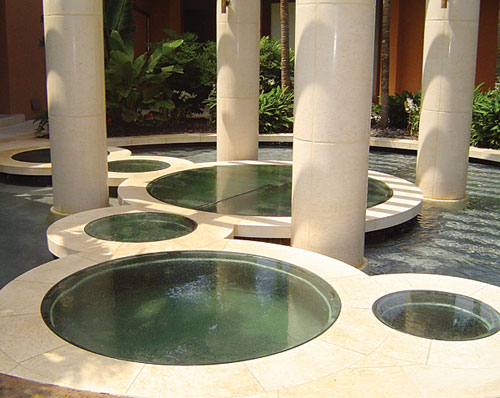Strategies for More Sustainable Exterior Solutions
STRATEGY #5: Structural glass flooring
Optimizing safety, performance and daylight harnessing
When it comes to dramatic design elements, it is difficult to imagine anything more dramatic in appearance than the selection of glass flooring. Glass flooring can be used to bring daylight as well as drama to any interior, serving as a beautiful and inspiring focal point. Manufacturers now have the ability to produce and utilize glass flooring panels for exterior installation that is interior on one side and exterior on the other. They are able to add a separate layer of laminated glass to the bottom of the glass flooring panel via insulated glass technologies. This allows one to take advantage of the energy efficiencies of insulated glass with glass flooring panels.
Consider safety as the most important criteria when specifying glass-flooring. The glass flooring product should be durable and easy to maintain. To optimize occupant health and comfort, professionals should consider these main points:
ADA compliant anti-slip walking surface
An anti-slip walking surface needs to exceed the ADA (Americans with Disabilities Act) requirements of a static coefficient of friction of 0.5. Various anti-slip surfaces are available and it is important to verify that the selected surface meets the ADA requirements. One of these options is a glass aggregate that is melted into the top walking surface of the glass. This product, being a clear glass, allows for a clean line of site due to the lack of visual recognition of the anti-slip surface. Ceramic frit is another product that can be specified as a glass floor finish. This product is silk screened onto the top of the glass, much like a t-shirt is printed. The product is then baked onto the top walking surface during the tempering process. Some manufacturers have also produced sandblasted finishes, however, these are difficult to clean and become dirty quickly.
Glass make-up and structural integrity
To assure structural integrity, professionals should work only with an experienced manufacturer/supplier. A structural glass engineer should be used to determine the make up of the glass panels. Many manufacturers offer their own engineering for a small fee. The glass should be engineered to adhere to the new American Society of Testing and Materials (ASTM) standard which will be made published in the near future. It will state that the glass flooring panel should include 3 layers of glass and 2 layers of lamination. The panels should properly handle spans associated with deflection rates from standard applied weight.
Modesty/ Privacy
When specifying a glass flooring product, architects should review the privacy aspects of the installation. In public applications an "obscure" product should be used so that improprieties do not occur. This obscure or translucent product should still allow for light to pass through the glass.
Daylight harvesting
Daylight harvesting is the practice of capturing light from an exterior wall, by making adjacent walls and floors transparent so that light can travel freely across room interiors. The glass flooring product should allow for the maximum amount of daylight to pass. Therefore, the use of opaque anti-slip material should be avoided. Daylight harvesting reduces electrical consumption and provides access to nature by the occupants of a building. Numerous studies have proven that human performance is increased when exposed to daylight.
The intent of the Indoor Environmental Quality Credit 8.1: in the USGBC LEED® V3 reference guide is to provide occupants with a connection between the indoors and the outdoors. Using glass flooring panels for daylight harvesting is a means to create transparency or translucency for this important environmental strategy.
 |
Exterior glass flooring installed over a water feature in a private residence in Hawaii. Photo courtesy of Jockimo Inc. |
Â
Exterior installations
Laminated glass products historically have not worked well in exterior applications when the edges of glass are exposed to the elements. The development of new and improved lamination products has eliminated this concern allowing glass-flooring products to be used outdoors in exterior applications.









